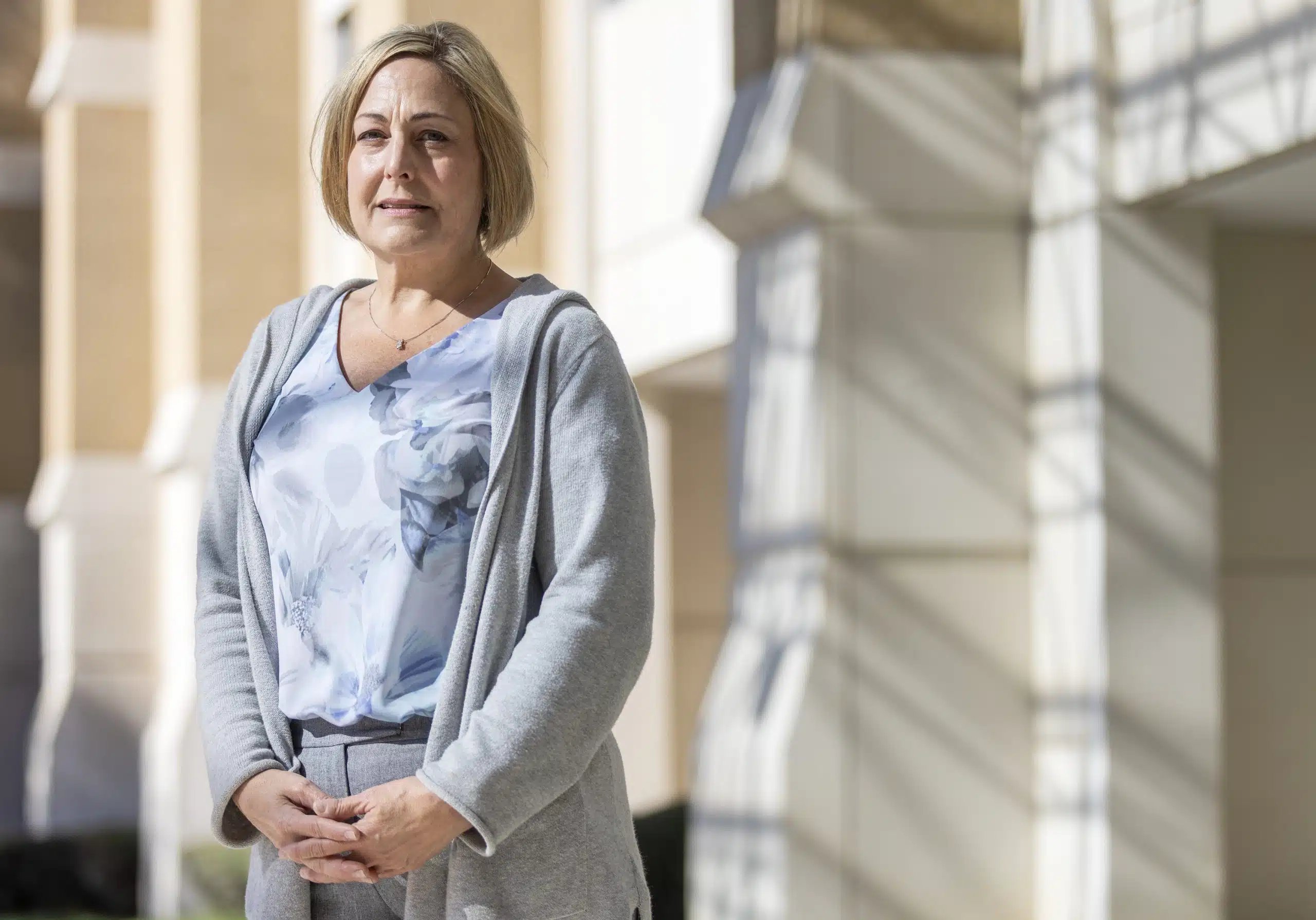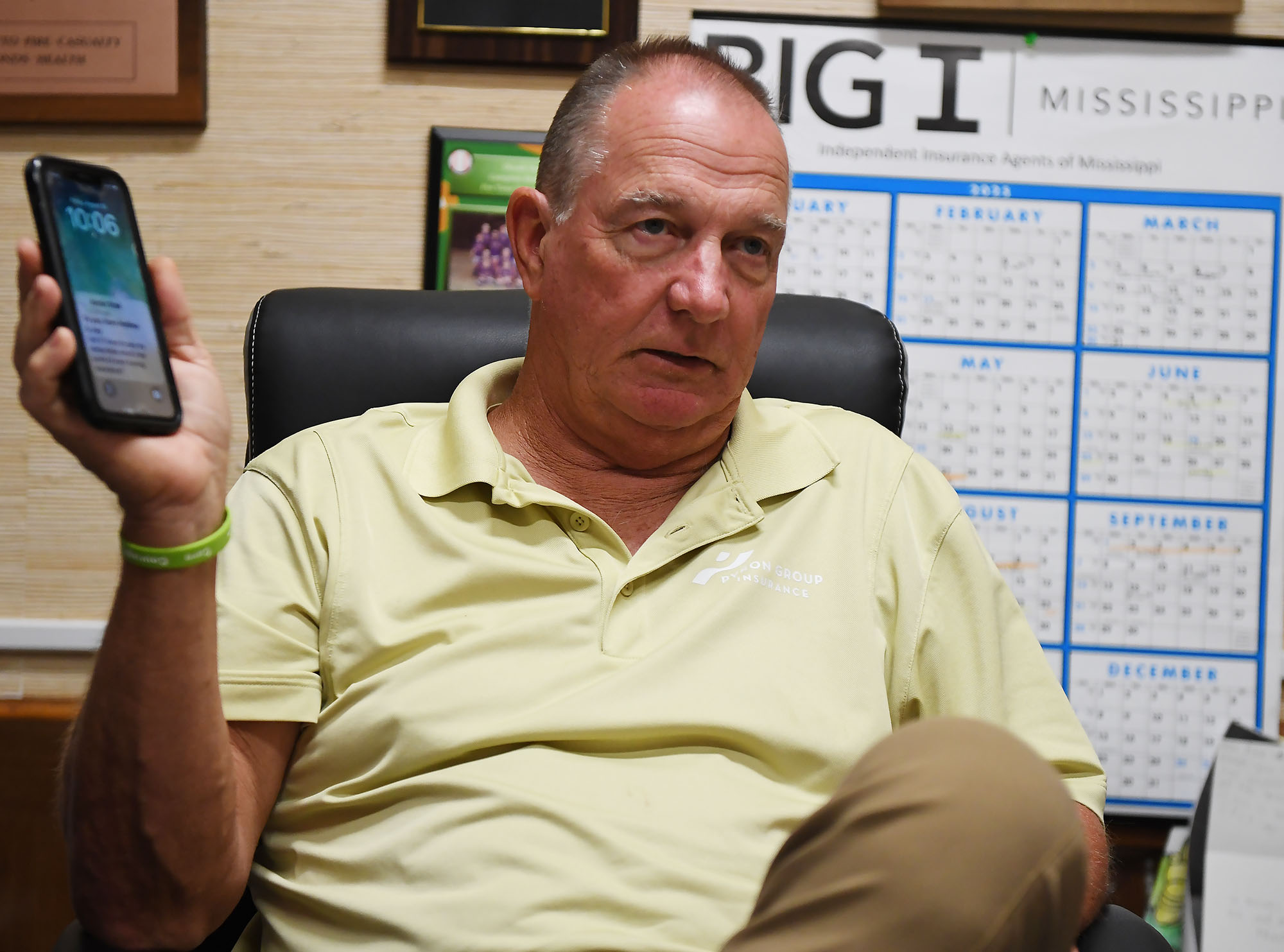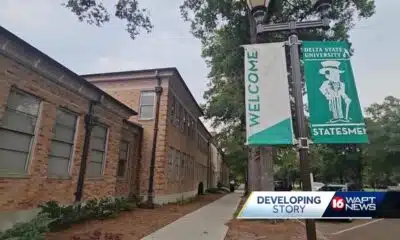Mississippi Today
Q&A with midwife Janice Scaggs

When Janice Scaggs joined the University of Mississippi Medical Center in 2020, she became part of a growing effort by the state’s largest public hospital and academic medical center to reintroduce midwifery into Mississippi’s maternal health care.
Certified nurse-midwives like Scaggs are educated in graduate-level midwifery programs and also hold an active registered nurse credential at the time of certification.
In the last three years, Scaggs, as the hospital’s only midwife, attended a little over six percent of births at UMMC each year.
In June, a second certified nurse midwife, Kim Rickard, joined the team. As part of the nurse midwifery clinical advisory committee, she and Scaggs plan to integrate a minimum of eight new nurse midwives into UMMC hospitals and clinics to offer round-the-clock midwifery care by 2027.
Midwives advocate for autonomy and comfort over efficiency for their patients, and have been proven to decrease unnecessary interventions such as cesareans in low-risk mothers – thereby improving morbidity and mortality, as well as postpartum mental health, and lowering the overall cost per capita of care.
Doctors and OB-GYNs are experts when it comes to abnormal pregnancies, Scaggs explained, but they don’t always know how to stand back and let a normal physiological birth unfold.
“Midwives … are the experts in normal, and have always been educated on a patient-centered model of care, really advocating for the patient and family, and empowering them,” she said.
Unnecessary cesareans and their increased use in Black pregnancies are not only a large contributor of preventable maternal deaths, but also a large contributor of maternal health disparities. Maternal mortality and morbidity after emergency cesarean birth is nearly 5 times than after vaginal birth.
Midwives are proponents of simple, but successful, low-intervention practices during labor – such as mobility and intermittent auscultation, or a technique of listening to and counting fetal heartbeats for a short period of time during active labor.
Editor’s note: This interview has been edited for clarity and length.
Mississippi Today: The term “midwife” translates to “with woman.” How do you see your role as a midwife, and how does it differ from that of, say, a doctor?
Janice Scaggs: We have so many similarities that sometimes that’s a really difficult question, but then on the other hand it’s really not.
If you look at the midwifery-led model of care, it really focuses on the individual, on putting them at the center of care, midwives being advocates for their patients and families – they want to empower the woman.
We focus on normal and healthy, certainly recognizing the abnormal. I look at us as the experts of that normal (births), whether it’s OB care, birthing, or gynecologic care, as well as family planning. I would say that that differs from our physician colleagues, because they really are focused on what the abnormal is, and they are experts when things are not going right.
MT: Tell me about the evidence around midwife-led care in reducing maternal and neonatal morbidity and mortality.
Scaggs: It’s well documented in other countries where midwifery is integrated into the health care system that it improves outcomes. We now have some good evidence in the U.S. to look at those evidence-based benefits, as well, including decreasing unnecessary interventions, improving the overall outcome of health – mental health as well as physical health – and decreasing the cost of health care, as well.
We increase breastfeeding rates, decrease preterm birth rates, and then (use) that approach of not using intervention unless absolutely necessary. We end up not performing interventions that can lead to morbidity, when maybe they didn’t need to be done, such as an unnecessary primary cesarean section.
MT: So, in today’s world, more women give birth in hospitals, and around technology, than ever before. But that hasn’t necessarily led to better outcomes. We know that because of infant and maternal mortality rates, and also high cesarean rates – across the country but particularly in Mississippi. Tell me about your non-pharmacological approach to birth and your philosophy around that.
Scaggs: I look at non-pharmacologic support as being an option that can either be done on its own or can be integrated with medical technology and pharmacologic options for women, as well. So they don’t have to stand separated.
But if we’re focusing on non-pharmacologic, we know from research that mobility, upright positions in the first stage of labor, decreases the length of labor, it decreases other interventions, it decreases cesarean rate. It improves comfort for moms who are trying to cope with labor without pharmacologic methods.
So, giving women permission and opportunity to move in labor – they will and they want to. If we put them in a bed and don’t encourage them to move, they won’t, because they feel unempowered, they don’t feel like they can safely move around.
That non-pharmacologic approach to giving women options, having them understand they are safe options in most settings, and we’re talking about primarily low-risk births with midwives. And then looking at things like acupressure points can be extremely helpful, using heat and cold in different aspects can be helpful. Touch – we know that there’s therapeutic touch for all aspects of health care, and that includes in labor and birth.
Using things like birthing balls when women are either in the bed, when they may be tired, either with epidurals or without epidurals, for positioning, can be extremely helpful in opening the pelvis to its most optimal position so that the fetus can get into the most optimal position. Babies come out a lot easier if they are head down and looking down, in relation to mom’s body, as opposed to what I would call sunny side up or coming down a little bit crooked. Changing the shape of the pelvis and having mom moving, whether it’s in the bed or out of bed, does lead to better outcomes, insofar as getting baby in a good position and having a faster labor.
It als just helps mom to cope better. When you’re hurt, you want to move. And if women stay in one position and don’t move, then we know that they’re not going to cope as well. I always talk to students and moms about how part of my job is to help you recognize when you’re suffering and to help you cope and to limit suffering. We know that doing that for women in labor actually improves our mental health outcomes and in the postpartum period it decreases anxiety and depression. And we know that that is something we should all be focusing on, and we’re just beginning to see more attention to that mental health aspect of the process of labor and birth.
MT: So, midwives primarily use intermittent auscultation, as opposed to electronic fetal heart monitoring, to listen to fetal heartbeat. Can you explain the difference between the two and how EFM can increase one’s chances of an unnecessary cesarean?
Scaggs: Continuous electronic fetal heart monitoring has two small, round devices – plastic devices that fit on mom’s belly. One graphs on a computer system to show when (the mother) is having a contraction. The other one is a little ultrasound piece. It’s not an ultrasound visually; it’s for hearing. We hear the heart rate, or auscultate the heart rate. And on these monitors, you can have continuous monitoring of the fetal heart rate, as well as uterine contractions.
We introduced this thinking we were going to decrease the overall cerebral palsy rate and we didn’t quite have the evidence to support that. And we have found now, 25, 35 years later, that for high-risk women, it’s extremely advantageous to have continuous electronic fetal monitoring. But for low-risk women, who are in spontaneous labor, who don’t have risk factors, we many times actually offer or perform interventions that aren’t necessary because (the continuous electronic monitoring) really sometimes provides more information than we need to have.
If we use intermittent auscultation, which is using either a handheld little Doppler which is another ultrasound device to hear heart tones, or even the old fashioned fetoscope that looks like the ear trumpet, that we can use to listen on mom’s belly. We listen before a contraction, throughout a contraction and one minute after the contraction, and we do that every 15 minutes during labor and five minutes during active labor and every five minutes when they’re pushing. And in doing that, if we hear anything abnormal we then can transition to more continuous monitoring to find out how the fetal heart is and to assure that we actually have a healthy baby. But you’re not having to be strapped down and continuously monitored. It may be that if everything sounds good and normal, that you never have to utilize the continuous electronic fetal monitoring.
MT: Tell me more about that relationship between a traumatic birth and postpartum depression.
Scaggs: Well, I can’t define trauma for somebody else, but if I don’t ask the right questions I’m not going to know if there’s been trauma.
I’ve had women who have come to postpartum visits, who I thought had the most beautiful birth and labor experience ever, and who seemed wonderful, and I find out a couple weeks later that there was something that caused them a trauma – whether it was terminology that was used, whether it was moving forward with a plan that maybe was not clear to them.
I’ve seen women have emergency cesarean sections who really needed them who show no signs of trauma, and then women who have planned cesareans who have trauma related to that. I think there are so many small things we can do to decrease trauma for women and that’s going to be, number one, communicating and finding out what helps them the best, not necessarily ourselves.
And as a provider, of any kind, whether you’re a midwife, a physician, a nurse, you can love your job so much and impose what you think somebody else should need. Being very self aware and self reflective, having humility of the process of labor and birth, is one of the best ways I think we can eliminate severe trauma.
MT: Do you think Mississippi will ever have a birth center? Would that be helpful here?
Scaggs: I think it would be wonderful if we could have regional freestanding birth centers that are supported by nurse-midwives with, you know, appropriate consultation, collaboration and referral to OB-GYNs and maternal-fetal medicine physicians for care as needed.
It would give us a better sense of community support in places where we don’t have as good of access. It could provide prenatal care, as well as care for labor, birth and postpartum period, as well as family planning.
MT: What do you think is needed to shift the paradigm from the hospital model of birth, which relies so heavily on technology, to a model of fewer interventions for low-risk pregnancies and empowering women to give birth according to their own plan when safe?
Scaggs: That’s a big question and I think it has a multifaceted answer. I think it always comes down to: what is the culture for supporting intended vaginal birth? What is the culture for putting women in the center of care? And what the relationships are between health care providers and nurses within a hospital, and support from administration for the type of training that is needed to be able to do things like intermittent auscultation. There’s a specific way to do that. So there needs to be education for nurses to be able to learn that; there needs to be a better nurse to patient ratio. So, we have some workforce issues. There’s also financial issues, educational issues. The bottom line is it’s really difficult to change culture. It takes time.
The more we can lean into family-centered, patient-centered, care, the more we can use the evidence that we currently have around us to improve outcomes.
If Mississippi can integrate midwifery into the health care system, that’s going to be the simplest answer. Who better to change the culture than midwives, who are the experts in normal, and have always been educated on a patient-centered model of care, really advocating for the patient and family, and empowering them, as well. The more we can empower women to have these choices and to understand they have these choices is really going to help.
MT: Is there anything else you’d like to add about midwifery in Mississippi?
Scaggs: I would like to say that I have been very supported within the university and from the chair of the department (Dr. Marty Tucker), to be able to grow midwifery. He’s the one who initially reached out to me when I had moved to Mississippi and was trying to navigate and figure out where jobs were and not finding many. He believes in midwifery being integrated into our model of care.
And I think if we had more physicians and administrators who understood midwifery and were open to hearing about it and really looking at the evidence, that we would have more midwives in Mississippi. But it takes us partnering to do that. I need them, and I need for them to realize also that they need my profession in order to best care for women in the state.
This article first appeared on Mississippi Today and is republished here under a Creative Commons license.
Did you miss our previous article…
https://www.biloxinewsevents.com/?p=310033
Mississippi Today
Mississippi prepares for another execution
The Mississippi Supreme Court has set the execution of a man who kidnapped and murdered a 20-year-old community college student in north Mississippi 30 years ago.
Charles Ray Crawford, 59, is set to be executed Oct. 15 at the Mississippi State Penitentiary at Parchman, after multiple requests by the attorney general’s office.
Eight justices joined the majority opinion to set the execution, concluding that Crawford has exhausted all state and federal legal remedies. Mississippi Supreme Court Justice T. Kenneth Griffis Jr. wrote the Friday opinion. Justice David Sullivan did not participate.
However, Kristy Noble with the Mississippi Office of Capital Post-Conviction Counsel released a statement saying it will file another appeal with the U.S. Supreme Court.
“”Mr. Crawford’s inexperienced trial counsel conceded his guilt to the jury — against Mr.
Crawford’s timely and repeated objections,” Noble said in the statement. “Mr. Crawford told his counsel to pursue a not guilty verdict. Counsel did just the opposite, which is precisely what the U.S. Supreme Court says counsel cannot do,” Noble said in the statement.
“A trial like Mr. Crawford’s – one where counsel concedes guilt over his client’s express wishes – is essentially no trial at all.”
Last fall, Crawford’s attorneys asked the court not to set an execution date because he hadn’t exhausted appeal efforts in federal court to challenge a rape conviction that is not tied to his death sentence. In June, the U.S. Supreme Court declined to take up Crawford’s case.
A similar delay occurred a decade ago, when the AG’s office asked the court to reset Crawford’s execution date, but that was denied because efforts to appeal his unrelated rape conviction were still pending.
After each unsuccessful filing, the attorney general’s office asked the Mississippi Supreme Court to set Crawford’s execution date.
On Friday, the court also denied Crawford’s third petition for post-conviction relief and a request for oral argument. It accepted the state’s motion to dismiss the petition. Seven justices concurred and Justice Leslie King concurred in result only. Again, Justice Sullivan did not participate.
Crawford was convicted and sentenced to death in Lafayette County for the 1993 rape and murder of North Mississippi Community College student Kristy Ray.
Days before he was set to go to trial on separate aggravated assault and rape charges, he kidnapped Ray from her parents’ Tippah County home, leaving ransom notes. Crawford took Ray to an abandoned barn where he stabbed her, and his DNA was found on her, indicating he sexually assaulted her, according to court records.
Crawford told police he had blackouts and only remembered parts of the crime, but not killing Ray. Later he admitted “he must of killed her” and led police to Ray’s body, according to court records.
At his 1994 trial he presented an insanity defense, including that he suffered from psychogenic amnesia – periods of time lapse without memory. Medical experts who provided rebuttal testimony said Crawford didn’t have psychogenic amnesia and didn’t show evidence of bipolar illness.
The last person executed in Mississippi was Richard Jordan in June, previously the state’s oldest and longest serving person on death row.
There are 36 people on death row, according to records from the Mississippi Department of Corrections.
Update 9/15/25: This story has been updated to include a response from the Mississippi Office of Capital Post-Conviction Counsel
This article first appeared on Mississippi Today and is republished here under a Creative Commons Attribution-NoDerivatives 4.0 International License.
The post Mississippi prepares for another execution appeared first on mississippitoday.org
Note: The following A.I. based commentary is not part of the original article, reproduced above, but is offered in the hopes that it will promote greater media literacy and critical thinking, by making any potential bias more visible to the reader –Staff Editor.
Political Bias Rating: Centrist
The article presents a factual and balanced account of the legal proceedings surrounding a scheduled execution in Mississippi. It includes perspectives from both the state’s attorney general’s office and the defense counsel, without using emotionally charged language or advocating for a particular political stance. The focus on legal details and court decisions reflects a neutral, informative approach typical of centrist reporting.
Mississippi Today
Presidents are taking longer to declare major natural disasters. For some, the wait is agonizing
TYLERTOWN — As an ominous storm approached Buddy Anthony’s one-story brick home, he took shelter in his new Ford F-250 pickup parked under a nearby carport.
Seconds later, a tornado tore apart Anthony’s home and damaged the truck while lifting it partly in the air. Anthony emerged unhurt. But he had to replace his vehicle with a used truck that became his home while waiting for President Donald Trump to issue a major disaster declaration so that federal money would be freed for individuals reeling from loss. That took weeks.
“You wake up in the truck and look out the windshield and see nothing. That’s hard. That’s hard to swallow,” Anthony said.
Disaster survivors are having to wait longer to get aid from the federal government, according to a new Associated Press analysis of decades of data. On average, it took less than two weeks for a governor’s request for a presidential disaster declaration to be granted in the 1990s and early 2000s. That rose to about three weeks during the past decade under presidents from both major parties. It’s taking more than a month, on average, during Trump’s current term, the AP found.
The delays mean individuals must wait to receive federal aid for daily living expenses, temporary lodging and home repairs. Delays in disaster declarations also can hamper recovery efforts by local officials uncertain whether they will receive federal reimbursement for cleaning up debris and rebuilding infrastructure. The AP collaborated with Mississippi Today and Mississippi Free Press on the effects of these delays for this report.
“The message that I get in the delay, particularly for the individual assistance, is that the federal government has turned its back on its own people,” said Bob Griffin, dean of the College of Emergency Preparedness, Homeland Security and Cybersecurity at the University at Albany in New York. “It’s a fundamental shift in the position of this country.”
The wait for disaster aid has grown as Trump remakes government
The Federal Emergency Management Agency often consults immediately with communities to coordinate their initial disaster response. But direct payments to individuals, nonprofits and local governments must wait for a major disaster declaration from the president, who first must receive a request from a state, territory or tribe. Major disaster declarations are intended only for the most damaging events that are beyond the resources of states and local governments.
Trump has approved more than two dozen major disaster declarations since taking office in January, with an average wait of almost 34 days after a request. That ranged from a one-day turnaround after July’s deadly flash flooding in Texas to a 67-day wait after a request for aid because of a Michigan ice storm. The average wait is up from a 24-day delay during his first term and is nearly four times as long as the average for former Republican President George H.W. Bush, whose term from 1989-1993 coincided with the implementation of a new federal law setting parameters for disaster determinations.
The delays have grown over time, regardless of the party in power. Former Democratic President Joe Biden, in his last year in office, averaged 26 days to declare major disasters — longer than any year under former Democratic President Barack Obama.

FEMA did not respond to the AP’s questions about what factors are contributing to the trend.
Others familiar with FEMA noted that its process for assessing and documenting natural disasters has become more complex over time. Disasters have also become more frequent and intense because of climate change, which is mostly caused by the burning of fuels such as gas, coal and oil.
The wait for disaster declarations has spiked as Trump’s administration undertakes an ambitious makeover of the federal government that has shed thousands of workers and reexamined the role of FEMA. A recently published letter from current and former FEMA employees warned the cuts could become debilitating if faced with a large-enough disaster. The letter also lamented that the Trump administration has stopped maintaining or removed long-term planning tools focused on extreme weather and disasters.
Shortly after taking office, Trump floated the idea of “getting rid” of FEMA, asserting: “It’s very bureaucratic, and it’s very slow.”
FEMA’s acting chief suggested more recently that states should shoulder more responsibility for disaster recovery, though FEMA thus far has continued to cover three-fourths of the costs of public assistance to local governments, as required under federal law. FEMA pays the full cost of its individual assistance.
Former FEMA Administrator Pete Gaynor, who served during Trump’s first term, said the delay in issuing major disaster declarations likely is related to a renewed focus on making sure the federal government isn’t paying for things state and local governments could handle.
“I think they’re probably giving those requests more scrutiny,” Gaynor said. “And I think it’s probably the right thing to do, because I think the (disaster) declaration process has become the ‘easy button’ for states.”
The Associated Press on Monday received a statement from White House spokeswoman Abigail Jackson in response to a question about why it is taking longer to issue major natural disaster declarations:
“President Trump provides a more thorough review of disaster declaration requests than any Administration has before him. Gone are the days of rubber stamping FEMA recommendations – that’s not a bug, that’s a feature. Under prior Administrations, FEMA’s outsized role created a bloated bureaucracy that disincentivized state investment in their own resilience. President Trump is committed to right-sizing the Federal government while empowering state and local governments by enabling them to better understand, plan for, and ultimately address the needs of their citizens. The Trump Administration has expeditiously provided assistance to disasters while ensuring taxpayer dollars are spent wisely to supplement state actions, not replace them.”

In Mississippi, frustration festered during wait for aid
The tornado that struck Anthony’s home in rural Tylertown on March 15 packed winds up to 140 mph. It was part of a powerful system that wrecked homes, businesses and lives across multiple states.
Mississippi’s governor requested a federal disaster declaration on April 1. Trump granted that request 50 days later, on May 21, while approving aid for both individuals and public entities.
On that same day, Trump also approved eight other major disaster declarations for storms, floods or fires in seven other states. In most cases, more than a month had passed since the request and about two months since the date of those disasters.
If a presidential declaration and federal money had come sooner, Anthony said he wouldn’t have needed to spend weeks sleeping in a truck before he could afford to rent the trailer where he is now living. His house was uninsured, Anthony said, and FEMA eventually gave him $30,000.
In nearby Jayess in Lawrence County, Dana Grimes had insurance but not enough to cover the full value of her damaged home. After the eventual federal declaration, Grimes said FEMA provided about $750 for emergency expenses, but she is now waiting for the agency to determine whether she can receive more.

“We couldn’t figure out why the president took so long to help people in this country,” Grimes said. “I just want to tie up strings and move on. But FEMA — I’m still fooling with FEMA.”
Jonathan Young said he gave up on applying for FEMA aid after the Tylertown tornado killed his 7-year-old son and destroyed their home. The process seemed too difficult, and federal officials wanted paperwork he didn’t have, Young said. He made ends meet by working for those cleaning up from the storm.
“It’s a therapy for me,” Young said, “to pick up the debris that took my son away from me.”
Historically, presidential disaster declarations containing individual assistance have been approved more quickly than those providing assistance only to public entities, according to the AP’s analysis. That remains the case under Trump, though declarations for both types are taking longer.
About half the major disaster declarations approved by Trump this year have included individual assistance.
Some people whose homes are damaged turn to shelters hosted by churches or local nonprofit organizations in the initial chaotic days after a disaster. Others stay with friends or family or go to a hotel, if they can afford it.
But some insist on staying in damaged homes, even if they are unsafe, said Chris Smith, who administered FEMA’s individual assistance division under three presidents from 2015-2022. If homes aren’t repaired properly, mold can grow, compounding the recovery challenges.

That’s why it’s critical for FEMA’s individual assistance to get approved quickly — ideally, within two weeks of a disaster, said Smith, who’s now a disaster consultant for governments and companies.
“You want to keep the people where they are living. You want to ensure those communities are going to continue to be viable and recover,” Smith said. “And the earlier that individual assistance can be delivered … the earlier recovery can start.”
In the periods waiting for declarations, the pressure falls on local officials and volunteers to care for victims and distribute supplies.
In Walthall County, where Tylertown is, insurance agent Les Lampton remembered watching the weather news as the first tornado missed his house by just an eighth of a mile. Lampton, who moonlights as a volunteer firefighter, navigated the collapsed trees in his yard and jumped into action. About 45 minutes later, the second tornado hit just a mile away.
“It was just chaos from there on out,” Lampton said.
Walthall County, with a population of about 14,000, hasn’t had a working tornado siren in about 30 years, Lampton said. He added there isn’t a public safe room in the area, although a lot of residents have ones in their home.
Rural areas with limited resources are hit hard by delays in receiving funds through FEMA’s public assistance program, which, unlike individual assistance, only reimburses local entities after their bills are paid. Long waits can stoke uncertainty and lead cost-conscious local officials to pause or scale-back their recovery efforts.

In Walthall County, officials initially spent about $700,000 cleaning up debris, then suspended the cleanup for more than a month because they couldn’t afford to spend more without assurance they would receive federal reimbursement, said county emergency manager Royce McKee. Meanwhile, rubble from splintered trees and shattered homes remained piled along the roadside, creating unsafe obstacles for motorists and habitat for snakes and rodents.
When it received the federal declaration, Walthall County took out a multimillion-dollar loan to pay contractors to resume the cleanup.
“We’re going to pay interest and pay that money back until FEMA pays us,” said Byran Martin, an elected county supervisor. “We’re hopeful that we’ll get some money by the first of the year, but people are telling us that it could be [longer].”
Lampton, who took after his father when he joined the volunteer firefighters 40 years ago, lauded the support of outside groups such as Cajun Navy, Eight Days of Hope, Samaritan’s Purse and others. That’s not to mention the neighbors who brought their own skid steers and power saws to help clear trees and other debris, he added.
“That’s the only thing that got us through this storm, neighbors helping neighbors,” Lampton said. “If we waited on the government, we were going to be in bad shape.”
Lieb reported from Jefferson City, Missouri, and Wildeman from Hartford, Connecticut.
Update 98/25: This story has been updated to include a White House statement released after publication.
This article first appeared on Mississippi Today and is republished here under a Creative Commons Attribution-NoDerivatives 4.0 International License.
The post Presidents are taking longer to declare major natural disasters. For some, the wait is agonizing appeared first on mississippitoday.org
Note: The following A.I. based commentary is not part of the original article, reproduced above, but is offered in the hopes that it will promote greater media literacy and critical thinking, by making any potential bias more visible to the reader –Staff Editor.
Political Bias Rating: Center-Left
This article presents a critical view of the Trump administration’s handling of disaster declarations, highlighting delays and their negative impacts on affected individuals and communities. It emphasizes concerns about government downsizing and reduced federal support, themes often associated with center-left perspectives that favor robust government intervention and social safety nets. However, it also includes statements from Trump administration officials defending their approach, providing some balance. Overall, the tone and framing lean slightly left of center without being overtly partisan.
Mississippi Today
Northeast Mississippi speaker and worm farmer played key role in Coast recovery after Hurricane Katrina
The 20th anniversary of Hurricane Katrina slamming the Mississippi Gulf Coast has come and gone, rightfully garnering considerable media attention.
But still undercovered in the 20th anniversary saga of the storm that made landfall on Aug. 29, 2005, and caused unprecedented destruction is the role that a worm farmer from northeast Mississippi played in helping to revitalize the Coast.
House Speaker Billy McCoy, who died in 2019, was a worm farmer from the Prentiss, not Alcorn County, side of Rienzi — about as far away from the Gulf Coast as one could be in Mississippi.
McCoy grew other crops, but a staple of his operations was worm farming.
Early after the storm, the House speaker made a point of touring the Coast and visiting as many of the House members who lived on the Coast as he could to check on them.
But it was his action in the forum he loved the most — the Mississippi House — that is credited with being key to the Coast’s recovery.
Gov. Haley Barbour had called a special session about a month after the storm to take up multiple issues related to Katrina and the Gulf Coast’s survival and revitalization. The issue that received the most attention was Barbour’s proposal to remove the requirement that the casinos on the Coast be floating in the Mississippi Sound.
Katrina wreaked havoc on the floating casinos, and many operators said they would not rebuild if their casinos had to be in the Gulf waters. That was a crucial issue since the casinos were a major economic engine on the Coast, employing an estimated 30,000 in direct and indirect jobs.
It is difficult to fathom now the controversy surrounding Barbour’s proposal to allow the casinos to locate on land next to the water. Mississippi’s casino industry that was birthed with the early 1990s legislation was still new and controversial.
Various religious groups and others had continued to fight and oppose the casino industry and had made opposition to the expansion of gambling a priority.
Opposition to casinos and expansion of casinos was believed to be especially strong in rural areas, like those found in McCoy’s beloved northeast Mississippi. It was many of those rural areas that were the homes to rural white Democrats — now all but extinct in the Legislature but at the time still a force in the House.
So, voting in favor of casino expansion had the potential of being costly for what was McCoy’s base of power: the rural white Democrats.
Couple that with the fact that the Democratic-controlled House had been at odds with the Republican Barbour on multiple issues ranging from education funding to health care since Barbour was inaugurated in January 2004.
Barbour set records for the number of special sessions called by the governor. Those special sessions often were called to try to force the Democratic-controlled House to pass legislation it killed during the regular session.
The September 2005 special session was Barbour’s fifth of the year. For context, current Gov. Tate Reeves has called four in his nearly six years as governor.
There was little reason to expect McCoy to do Barbour’s bidding and lead the effort in the Legislature to pass his most controversial proposal: expanding casino gambling.
But when Barbour ally Lt. Gov. Amy Tuck, who presided over the Senate, refused to take up the controversial bill, Barbour was forced to turn to McCoy.
The former governor wrote about the circumstances in an essay he penned on the 20th anniversary of Hurricane Katrina for Mississippi Today Ideas.
“The Senate leadership, all Republicans, did not want to go first in passing the onshore casino law,” Barbour wrote. “So, I had to ask Speaker McCoy to allow it to come to the House floor and pass. He realized he should put the Coast and the state’s interests first. He did so, and the bill passed 61-53, with McCoy voting no.
“I will always admire Speaker McCoy, often my nemesis, for his integrity in putting the state first.”
Incidentally, former Rep. Bill Miles of Fulton, also in northeast Mississippi, was tasked by McCoy with counting, not whipping votes, to see if there was enough support in the House to pass the proposal. Not soon before the key vote, Miles said years later, he went to McCoy and told him there were more than enough votes to pass the legislation so he was voting no and broached the idea of the speaker also voting no.
It is likely that McCoy would have voted for the bill if his vote was needed.
Despite his no vote, the Biloxi Sun Herald newspaper ran a large photo of McCoy and hailed the Rienzi worm farmer as a hero for the Mississippi Gulf Coast.
This article first appeared on Mississippi Today and is republished here under a Creative Commons Attribution-NoDerivatives 4.0 International License.
The post Northeast Mississippi speaker and worm farmer played key role in Coast recovery after Hurricane Katrina appeared first on mississippitoday.org
Note: The following A.I. based commentary is not part of the original article, reproduced above, but is offered in the hopes that it will promote greater media literacy and critical thinking, by making any potential bias more visible to the reader –Staff Editor.
Political Bias Rating: Centrist
The article presents a factual and balanced account of the political dynamics surrounding Hurricane Katrina recovery efforts in Mississippi, focusing on bipartisan cooperation between Democratic and Republican leaders. It highlights the complexities of legislative decisions without overtly favoring one party or ideology, reflecting a neutral and informative tone typical of centrist reporting.
-
News from the South - North Carolina News Feed6 days ago
What we know about Charlie Kirk shooting suspect, how he was caught
-
Local News7 days ago
Russian drone incursion in Poland prompts NATO leaders to take stock of bigger threats
-
Local News Video7 days ago
Introducing our WXXV Student Athlete of the Week, St. Patrick’s Parker Talley!
-
News from the South - North Carolina News Feed6 days ago
Federal hate crime charge sought in Charlotte stabbing | North Carolina
-
The Center Square7 days ago
Weapon recovered as manhunt continues in Kirk assassination investigation | National
-
News from the South - Alabama News Feed7 days ago
News 5 NOW at 8:00am | September 11, 2025
-
News from the South - Arkansas News Feed5 days ago
NW Arkansas Championship expected to bring money to Rogers
-
Our Mississippi Home4 days ago
Screech Owls – Small but Cute











































